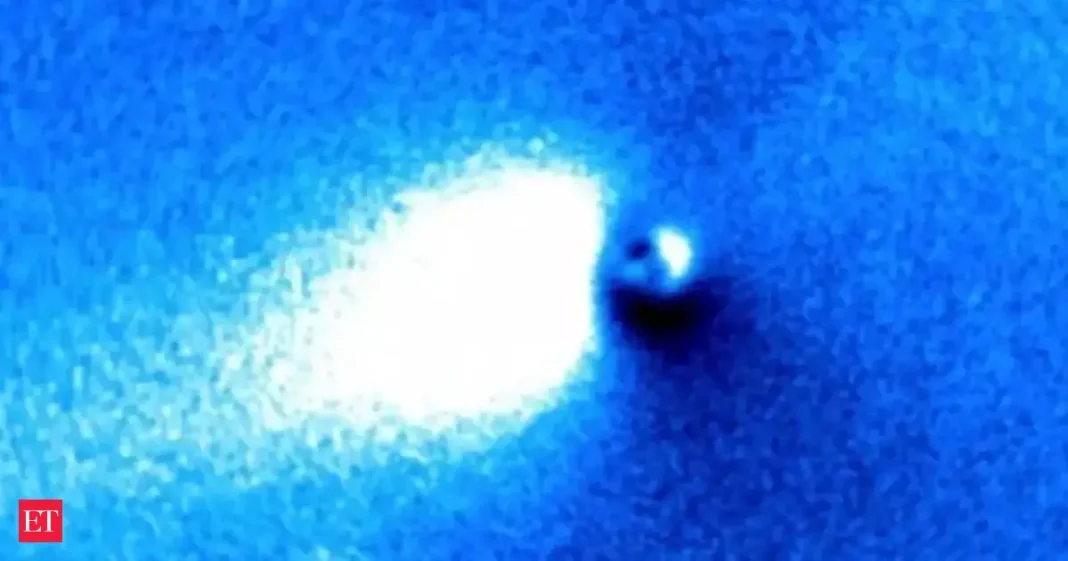The universe, in its vastness, occasionally sends us messengers from beyond our solar system, offering glimpses into other cosmic neighbourhoods. One such intriguing visitor is the interstellar comet 3I/ATLAS, a celestial nomad that captured global attention upon its discovery. However, what began as a source of excitement has now evolved into a perplexing scientific mystery, as new observations suggest an “unnatural” post-perihelion manoeuvre, raising fundamental questions about cometary physics, energy demands, and mass loss calculations. Astronomers worldwide, including the vibrant scientific community in India, are closely scrutinising this cosmic enigma, as it threatens to upend established models.
A Wanderer’s Peculiar Turn: The Enigma of 3I/ATLAS
Designated 3I/ATLAS (with ‘3I’ signifying it as the third identified interstellar object, following ‘Oumuamua and 2I/Borisov), this comet originated from a distant star system, traversing unimaginable cosmic distances before gracing our solar neighbourhood. Its trajectory confirmed its interstellar nature, tracing a hyperbolic path that indicated it would make a single pass around our Sun before slingshotting back into the void.
Comets, often dubbed “dirty snowballs,” are known for their spectacular behaviour as they approach the Sun. The Sun’s heat causes their volatile ices (water, carbon dioxide, etc.) to sublimate, forming a glowing coma and a distinctive tail. This outgassing also creates a “rocket effect,” providing a small but measurable non-gravitational acceleration, pushing the comet slightly off its purely gravitational path. Scientists meticulously calculate these effects to predict a comet’s trajectory and mass loss.
However, 3I/ATLAS began to defy these predictions post-perihelion – its closest approach to the Sun. Instead of exhibiting the expected, predictable outgassing-driven acceleration, data indicated a sudden, pronounced change in its trajectory, far exceeding what conventional models could explain. It was as if the comet had undergone an unforeseen, energetic “kick,” prompting astronomers to label its manoeuvre as profoundly unnatural for a body of its apparent composition and size.
Unpacking the Anomaly: Energy & Mass Loss Conundrums
The core of the mystery surrounding 3I/ATLAS lies in the profound discrepancy between the observed acceleration and the mechanisms known to drive cometary motion. If the comet’s deviation from its expected path were solely due to outgassing, the energy required for such a manoeuvre would be astronomical. Current estimates suggest that the observed acceleration would necessitate a phenomenal rate of mass expulsion, far exceeding what its apparent brightness and spectral data indicate.
Consider the energy budget: to achieve the inferred acceleration, 3I/ATLAS would have to be shedding an extraordinary amount of material, releasing kinetic energy orders of magnitude greater than typical comets. This level of activity should be accompanied by a corresponding increase in its coma’s brightness and a visible fragmentation or disintegration, neither of which has been consistently observed to the degree necessary to explain the manoeuvre. This creates a significant challenge for existing cometary models, which are generally robust in predicting the behaviour of solar system comets.
“The magnitude of the observed acceleration, if solely attributed to typical cometary outgassing, demands an energy expenditure that challenges our current understanding of these celestial bodies,” notes Dr. Aruna Prasad, a senior astrophysicist at the Indian Institute of Astrophysics, Bengaluru. “It prompts a rigorous re-evaluation of our mass loss calculations and the potential for hitherto unknown mechanisms at play.“
The implications are far-reaching. Are our calculations of comet mass loss fundamentally flawed for interstellar objects? Or is there an unknown source of energy or propulsive force at play? Scientists are grappling with these questions, exploring scenarios ranging from an exceptionally volatile internal composition to interactions with solar winds or magnetic fields that are far more complex than previously assumed. The lack of corresponding intense brightness or fragmentation makes the energy conundrum particularly acute, pushing the boundaries of what we understand about these icy wanderers.
The Global Search for Answers: India’s Gaze on the Cosmos
The puzzling behaviour of 3I/ATLAS has spurred an intensified period of observation and theoretical work across the globe. Telescopes and observatories, including those operated by ISRO and institutions like the Aryabhatta Research Institute of Observational Sciences (ARIES) in Nainital, are contributing to the collective effort to gather more data on this interstellar visitor. Indian astronomers, with their expertise in celestial mechanics and observational astronomy, are actively participating in the global discourse, sharing insights and scrutinising the complex data.
While the notion of “unnatural” behaviour might pique speculative interests, the scientific community remains firmly grounded in seeking natural explanations within the laws of physics. Researchers are exploring possibilities such as the presence of highly volatile, previously unobserved compounds within the comet, or a highly anisotropic (uneven) outgassing pattern that could create a strong, asymmetric thrust without requiring an overall massive loss of material. Another avenue involves reassessing the comet’s initial mass and density estimates, as a significantly lower density could mean the same observed acceleration requires less mass loss.
Ultimately, 3I/ATLAS serves as a powerful reminder of the vast unknowns that still pervade our understanding of the cosmos. Each interstellar visitor brings with it not just a piece of another star system, but also a fresh set of questions that compel us to refine our models and expand our scientific horizons. The “unnatural” manoeuvre of 3I/ATLAS is not just a scientific anomaly; it’s a profound invitation to delve deeper into the intricate dance of celestial mechanics and the fundamental physics governing the universe.
As observations continue and new theories are tested, the full story of 3I/ATLAS and its peculiar journey will undoubtedly unfold, enriching our knowledge of both our own solar system and the myriad others beyond.




